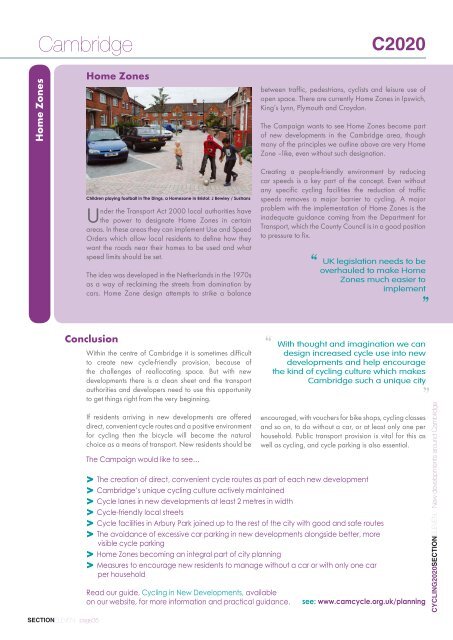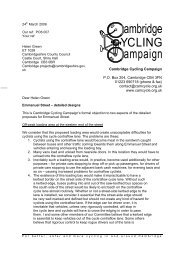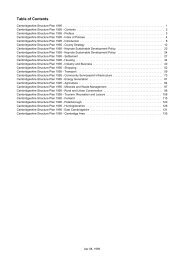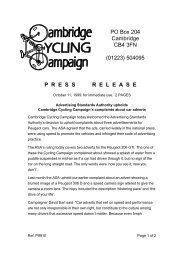Printable PDF version - Cambridge Cycling Campaign
Printable PDF version - Cambridge Cycling Campaign
Printable PDF version - Cambridge Cycling Campaign
- No tags were found...
Create successful ePaper yourself
Turn your PDF publications into a flip-book with our unique Google optimized e-Paper software.
<strong>Cambridge</strong>C2020Home ZonesHome ZonesChildren playing football in The Dings, a Homezone in Bristol: J Bewley / SustransUnder the Transport Act 2000 local authorities havethe power to designate Home Zones in certainareas. In these areas they can implement Use and SpeedOrders which allow local residents to define how theywant the roads near their homes to be used and whatspeed limits should be set.The idea was developed in the Netherlands in the 1970sas a way of reclaiming the streets from domination bycars. Home Zone design attempts to strike a balancebetween traffic, pedestrians, cyclists and leisure use ofopen space. There are currently Home Zones in Ipswich,King’s Lynn, Plymouth and Croydon.The <strong>Campaign</strong> wants to see Home Zones become partof new developments in the <strong>Cambridge</strong> area, thoughmany of the principles we outline above are very HomeZone –like, even without such designation.Creating a people-friendly environment by reducingcar speeds is a key part of the concept. Even withoutany specific cycling facilities the reduction of trafficspeeds removes a major barrier to cycling. A majorproblem with the implementation of Home Zones is theinadequate guidance coming from the Department forTransport, which the County Council is in a good positionto pressure to fix.“UK legislation needs to beoverhauled to make HomeZones much easier toimplement“ConclusionWithin the centre of <strong>Cambridge</strong> it is sometimes difficultto create new cycle-friendly provision, because ofthe challenges of reallocating space. But with newdevelopments there is a clean sheet and the transportauthorities and developers need to use this opportunityto get things right from the very beginning.If residents arriving in new developments are offereddirect, convenient cycle routes and a positive environmentfor cycling then the bicycle will become the naturalchoice as a means of transport. New residents should beThe <strong>Campaign</strong> would like to see…encouraged, with vouchers for bike shops, cycling classesand so on, to do without a car, or at least only one perhousehold. Public transport provision is vital for this aswell as cycling, and cycle parking is also essential.> The creation of direct, convenient cycle routes as part of each new development> <strong>Cambridge</strong>’s unique cycling culture actively maintained> Cycle lanes in new developments at least 2 metres in width> Cycle-friendly local streets> Cycle facilities in Arbury Park joined up to the rest of the city with good and safe routes> The avoidance of excessive car parking in new developments alongside better, morevisible cycle parking> Home Zones becoming an integral part of city planning> Measures to encourage new residents to manage without a car or with only one carper householdRead our guide, <strong>Cycling</strong> in New Developments, availableon our website, for more information and practical guidance.“With thought and imagination we candesign increased cycle use into newdevelopments and help encouragethe kind of cycling culture which makes<strong>Cambridge</strong> such a unique citysee: www.camcycle.org.uk/planning“CYCLING2020SECTIONELEVEN.. New developments around <strong>Cambridge</strong>SECTIONELEVEN.. page35







